ISSN ONLINE(2319-8753)PRINT(2347-6710)
ISSN ONLINE(2319-8753)PRINT(2347-6710)
Arun Babu K1 and M.Vijayakumar 2
|
| Related article at Pubmed, Scholar Google |
Visit for more related articles at International Journal of Innovative Research in Science, Engineering and Technology
Brush Less Direct Current (BLDC) motors are attaining higher priority in industrial automation, computers, aerospace, military, household appliance and traction applications because of its high efficiency, high power density and low maintenance cost. This makes the control of BLDC motor in all the four quadrants very vital. To control a BLDC machine, it is generally required to measure the speed and position of rotor by using the sensor. Using the measured value of rotor position, each inverter phase acting at precise time will be commutated. This paper deals with the digital control of three phase BLDC motor in all four quadrant operation. The motor is controlled in all the four quadrants without any loss of power; in fact energy is conserved during the regenerative period. This energy is stored in a battery storage system during regenerative period and can be fed back to the inverter mains during shortage of supply from the source. The FPGA controller is implemented which is more advantageous over other conventional controllers as it is computationally intensive, highly parallelizable tasks, best in class accuracy, reliability and maintenance. A PI controller in closed loop configuration is used for speed control. The torque ripple in each quadrant operation is also reduced using a closed loop operation with the aid of a low pass filter. The operation modes of the proposed system are simulated using MATLAB and results are validated.
Keywords |
| BLDC motor, FPGA, PI Controller, and Regenerative breaking. |
INTRODUCTION |
| For the past two decades several Asian countries such as India, Japan which has been under pressure from high energy prices, has implemented variable speed PM motor drives for energy saving applications such as air conditioners and refrigerators. On the other hand, the U.S.A has kept on using cheap induction motor drives, which have around 10% lower efficiency than adjustable PM motor drives for energy saving applications. Therefore recently, the increase in energy prices has spurred higher demands of variable speed PM motor drives. Also, the recent rapid proliferation of motor drives into the automobile industry, based on hybrid drives, generates a serious demand for high efficiency PM motor drives, and this was the beginning of interest in BLDC motors. BLDC motors, also called Permanent Magnet DC Synchronous motors, are one of the motor types that have more rapidly gained popularity, mainly because of their better characteristics and performance. These motors are used in a great amount of industrial sectors because their architecture is suitable for any safety critical applications. The BLDC motor is a synchronous electric motor that, from a modeling perspective [1-2], looks exactly like a DC motor, having a linear relationship between current and torque, voltage and RPM. BLDC motor is an electronically controlled commutation system, instead of having a mechanical commutation, which is typical of brushed motors. BLDC motors have many advantages over brushed DC motors and induction motors, such as a better speed versus torque characteristics, high dynamic response, high efficiency and reliability, long operating life (no brush erosion), noiseless operation, higher speed ranges, and reduction of electromagnetic interference (EMI). |
| In the literature, it has been shown that the regenerative braking system on DSP for single quadrant operation [3], four quadrant operation on switched reluctance motor drive [4], four quadrant operation of BLDC motor on DSP [5], four quadrant operation of three phase brushless DC motor with hysteresis current controller [6].The torque control previously studied shows the torque ripple due to phase commutation [7], torque control of small inductance in BLDC [8]. The study of the model construction for simulation is an important phase in the controller design process of the BLDC motor drives [5, 6, 9]. |
| In this paper the four quadrant operation of BLDC motor is studied on FPGA. Also a torque controller is designed to reduce the ripples present in conventional system. FPGA which is very advantageous over other controllers mainly digital controllers like dsPICs, due computation intensiveness, highly parallelizable tasks, best in class accuracy, reliability and maintenance is preferred. |
II. FOUR QUADRANT OPERATION |
| There are four possible modes or quadrants of operation using a Brushless DC Motor which is depicted in Fig 1. In an X-Y plot of speed versus torque, Quadrant I is forward speed and forward torque. The torque is propelling the motor in the forward direction. Conversely, Quadrant III is reverse speed and reverse torque. Now the motor is “motoring” in the reverse direction, spinning backwards with the reverse torque. Quadrant II is where the motor is spinning in the forward direction, but torque is being applied in reverse. Torque is being used to “brake” the motor, and the motor is now generating power as a result. Finally, Quadrant IV is exactly the opposite. The motor is spinning in the reverse direction, but the torque is being applied in the forward direction. Again, torque is being applied to attempt to slow the motor and change its direction to forward again. Once again, power is being generated by the motor. When BLDC motor (Fig. 2) is operating in the first and third quadrant, the supplied voltage is greater than the back EMF which is forward motoring and reverse motoring modes respectively, but the direction of current flow differs[5]. |
| When the motor operates in the second and fourth quadrant the value of the back EMF generated by the motor should be greater than the supplied voltage which are the forward braking and reverse braking modes of operation respectively, here again the direction of current flow is reversed. The BLDC motor is initially made to rotate in clockwise direction, but when the speed reversal command is obtained, the control goes into the clockwise regeneration mode, which brings the rotor to the standstill position. Instead of waiting for the absolute standstill position, continuous energization of the main phase is attempted. This rapidly slows down the rotor to a standstill position. Therefore, there is the necessity for determining the instant when the rotor of the machine is ideally positioned for reversal. Hall Effect sensors are used to ascertain the rotor position and from the Hall sensor outputs, it is determined whether the machine has reversed its direction. This is the ideal moment for energizing the stator phase so that the machine can start motoring in the counter clockwise direction[4-6]. |
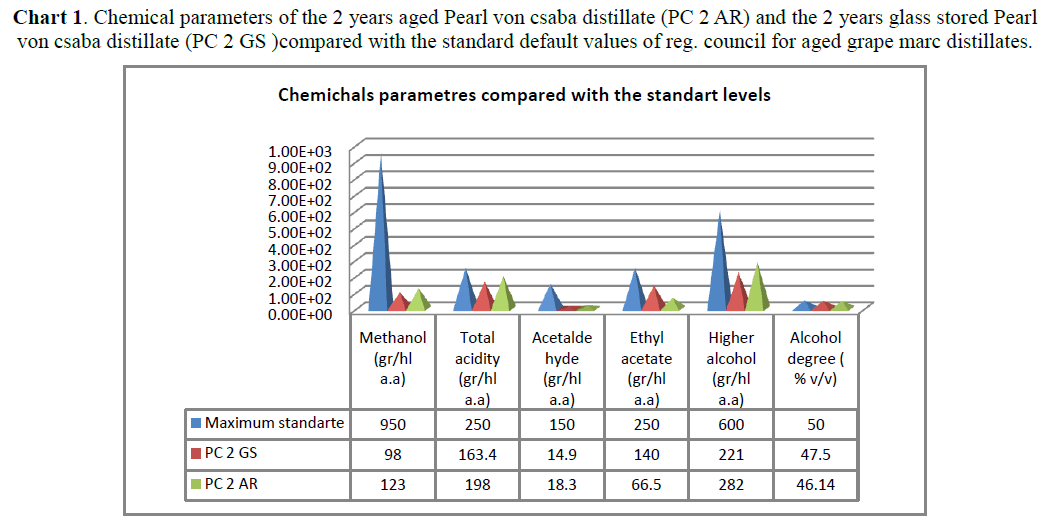 |
III. PROPOSED WORK |
| For the analysis of four quadrant operation of BLDC motor, a closed loop drive system is developed as shown in Fig 3. |
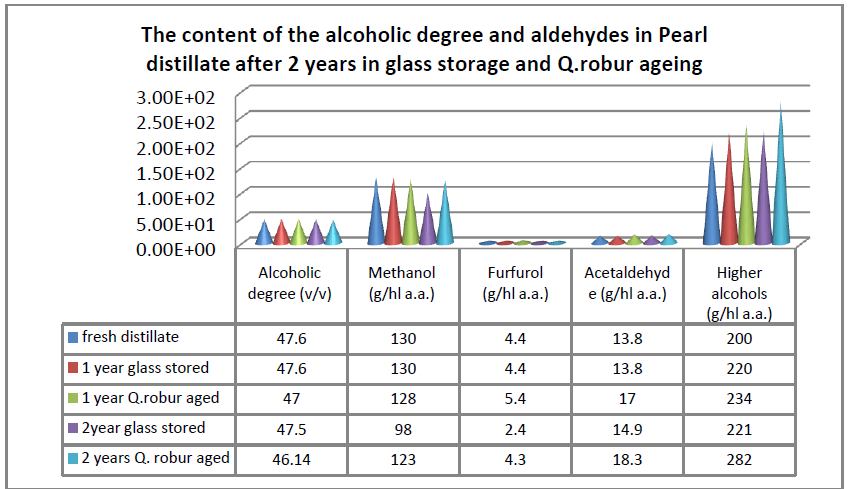 |
IV. CONTROLLER |
A. PI Controller |
| Regulation of speed is accomplished with PI Controller. By increasing the proportional gain of the speed controller, the controller’s sensitivity is increased to have faster reaction for small speed regulation errors. This allows a better initial tracking of the speed reference by a faster reaction of the current reference is sued by the speed controller. This increased sensitivity also reduces the speed overshooting. The armature current reduces faster, once the desired speed is achieved. An increase of the integral gain will allow the motor speed to catch up with the speed reference ramp a lot faster during sampling periods. This will indeed allow a faster reaction to small speed error integral terms that occur when a signal is regulated following a ramp. The controller will react in order to diminish the speed error integral a lot faster by producing a slightly higher accelerating torque when following an accelerating ramp. |
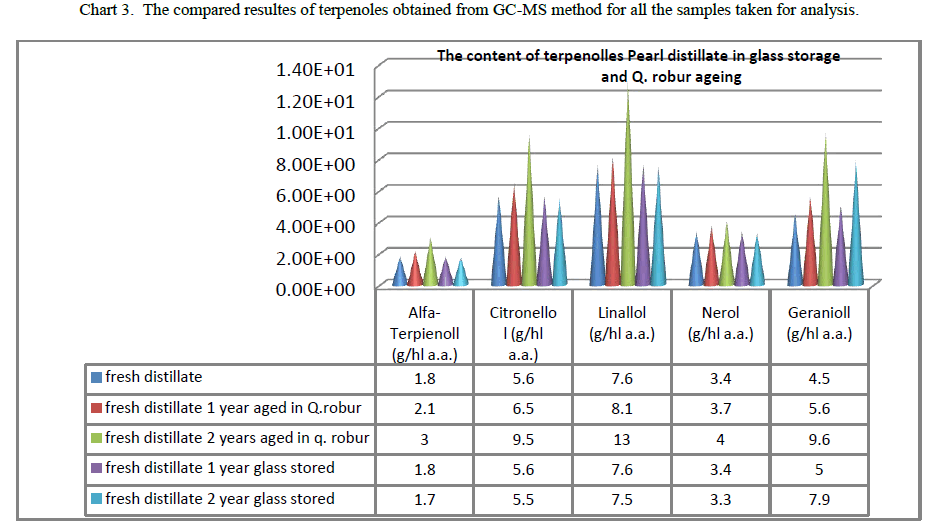 |
| On the other hand, very high increase of the proportional and integral gains can cause instability, and the controller becoming insensitive. Very high gains may also result in saturation. Tuning process is by trial and error method and the Proportional Constant and Integral Constant and thus found out. The effect of torque ripple on motor speed is shown in Fig. 4 |
B. PWM Module |
| Pulse Width Modulation (PWM) or Pulse Duration Modulation (PDM), is a commonly used technique for controlling power to inertial electrical devices, made practical by modern electronic power switches. The average value of voltage (and current) fed to the load is controlled by turning the switch between supply and load on and off at a fast pace. The longer the switch is on compared to the off period, the higher the power supplied to the load. The PWM switching frequency has to be much faster than what would affect the load, which is to say that device uses the power. Typically switching have to be done several times a minutes in an electric stove, 120 Hz in a lamp dimmer, from few kilohertz (KHz) to tens of KHz for a motor drive and well into the tens or hundreds of KHz in audio amplifiers and computer power supplies. |
C. Torque Controller |
| The proposed system operates in four different operating modes, thus the control of torque in four different regions has to be accomplished by the controller. Thus a torque controller is designed for the proposed system. Here an observer is designed with the help of a low pass filter. This controller is designed in closed loop configuration, which helps to reduce the torque ripples that are present in normal operation periods. The Figure 5 shows the structure of torque control unit for proposed system. |
| The influence of torque ripples in a traditional speed regulating loop is clear. The frequency on these ripples is proportional to the motor shaft speed. At high speed, high frequency torque ripples are naturally filtered by the shaft inertia. At low speed, high frequency torque ripples are well filtered by the PI or PI2 feedback controller. But when torque ripple frequency is close to the speed loop bandwidth (critical speed), torque ripples can cause important speed variations. Thus to reduce this problem a low pass filter is added to the closed loop system along with a transfer function. |
| The above control blocks then can be transferred to digital hardware circuit in VHDL hardware description language for co-simulation verification in the MATLAB/SIMULINK and ModelSim environment. Experiment results by using FPGA control are also obtained to verify the correctness of the constructed BLDC model (figure 5). |
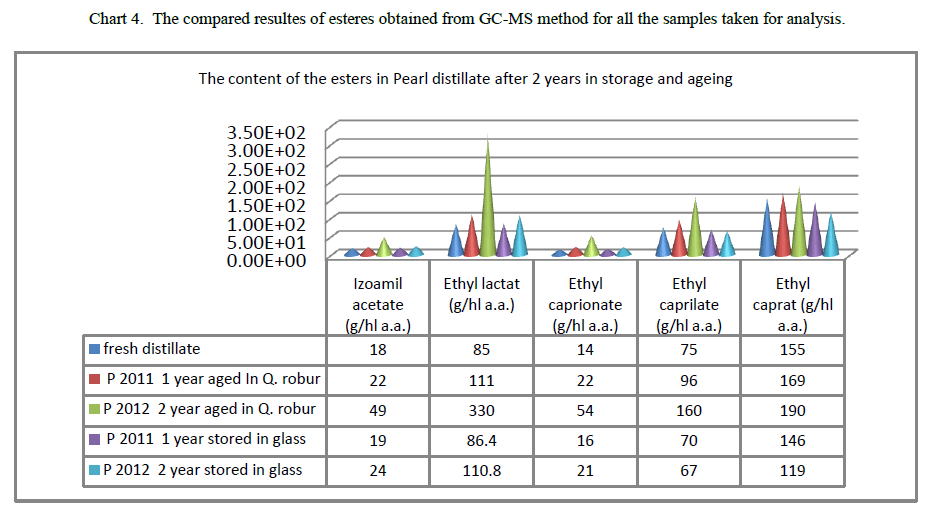 |
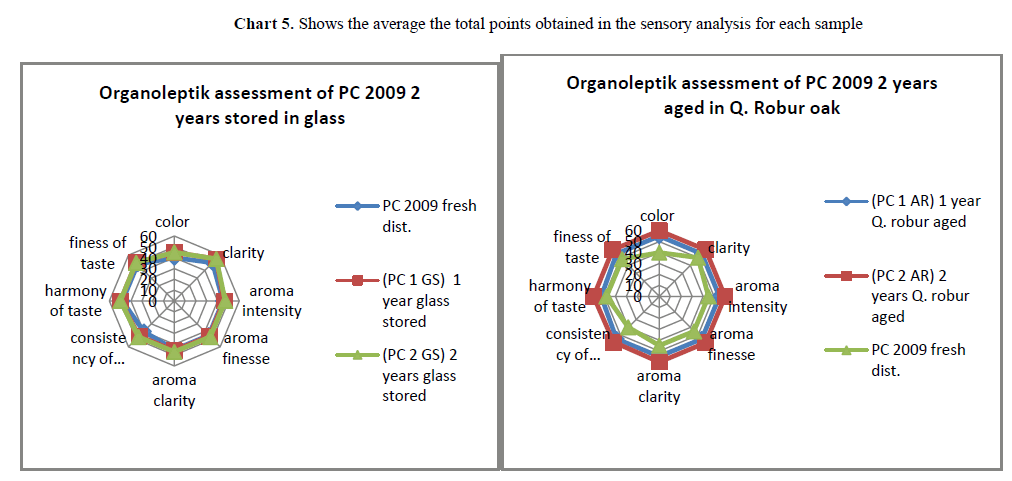 |
| The various operations and functions to be implemented in FPGA device is shown in Fig. 6.An FPGA control board and an IGBT-based inverter have been designed for the experiment to test the relationship of the inverter switch on-off states and the Hall sensor position. The Hall sensor state and the corresponding drive state require for commutation in clockwise rotating mode and counterclockwise rotating mode can be put in the form of a state table as shown in TABLE I and TABLE II, respectively. |
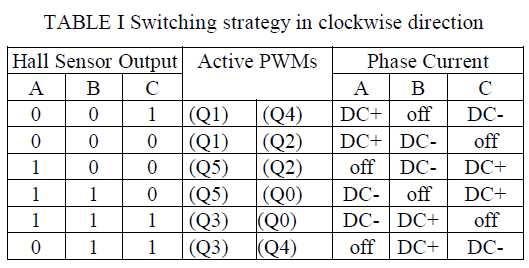 |
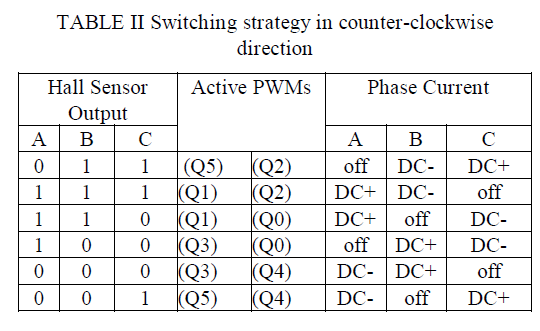 |
V. SIMULINK ENVIRONMENT |
A. Simulink Model |
| The closed loop controller for a three phase brushless DC motor is modeled using MATLAB/Simulink is shown in Fig.7. Permanent Magnet Synchronous motor with trapezoidal back EMF is modeled as a Brushless DC Motor. |
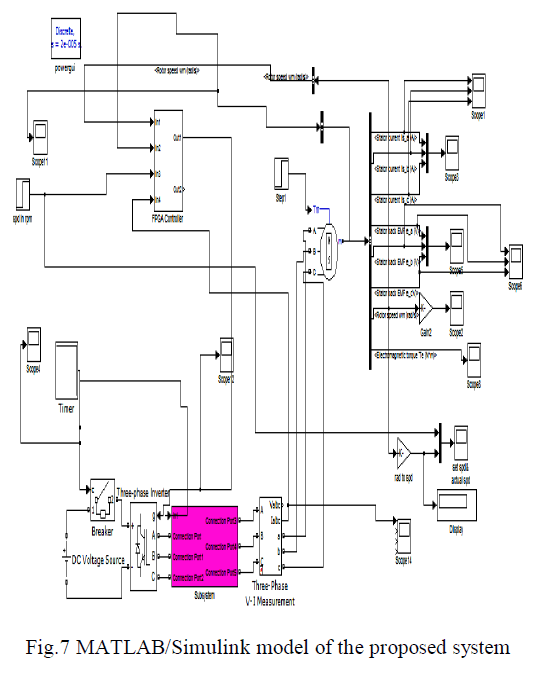 |
| In the proposed model the reference speed is set to 800 RPM. The time delay of 0.45seconds is required for the motor to reach the reference speed of 800 RPM from rest as the initial operation mode command is set. After reaching the reference speed the motor continues to operate in 800 RPM till next operation command is provided by the timer to breaker. The response time for change in modes of operation is achieved faster than the conventional system, where it takes 0.6seconds to reach the reference speed. The model of the controller shown in Fig. 8, receives the Hall signals as its input, converts it in to appropriate voltage signals. The gate signals are generated by comparing the actual speed with the reference speed. Thus a closed loop speed control is achieved with the help of PI control, present in the controller block. |
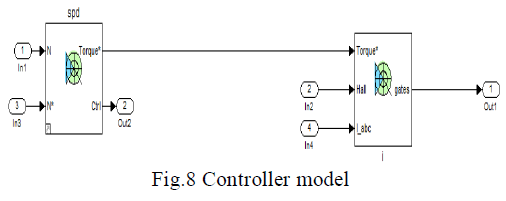 |
| During the braking modes of operation in conventional drive system the kinetic energy produced is lost as dissipated heat .This kinetic energy which will be wasted as heat energy during braking operation is converted into electric energy which is rectified and need to be stored separately. This stored energy can be given back to the mains during shortage of energy from source. The system that conserves the energy in a rechargeable battery during the braking mode is called as battery energy storage system. Nickel metal hydride battery is preferred because of its economical purpose and also for its long life. For higher storage of power, batteries are stacked in series. The Fig. 9 shows the energy storage system model used in the proposed system. The braker is provided so that during forward motoring, supply should not enter or leave from the energy storage system. |
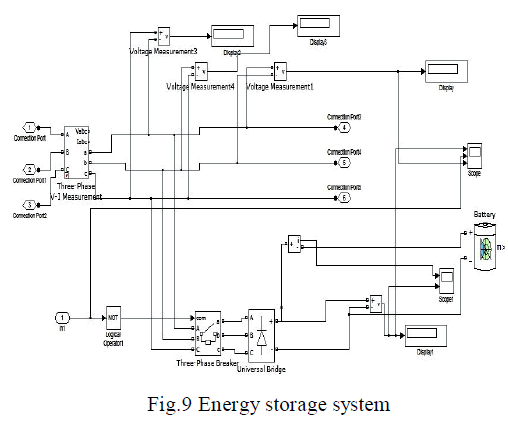 |
B. Simulink parameters |
| The performance of the proposed system is simulated using parameters listed in the TABLE III |
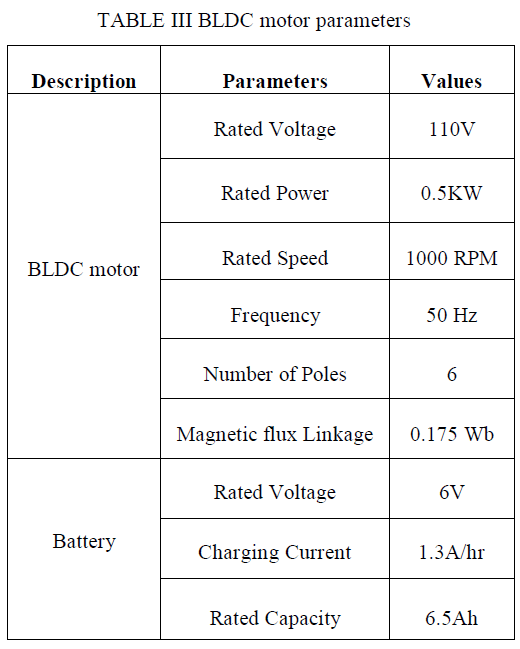 |
| The proposed four quadrant operation of BLDC motor has been implemented by computer simulation on a threephase, 6-pole modular machine. Fig. 10 shows the four quadrant operation of the BLDC motor at reference speed 800 RPM. |
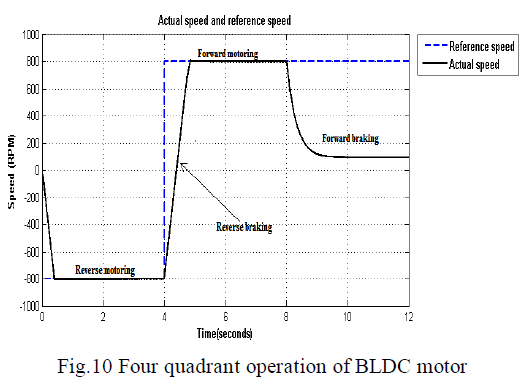 |
| The run time is set to 12 for the simulation of the proposed system,such that timer gives command to to the breaker for change in operation of quadrants.Fig. 11 shows the three phase back EMF |
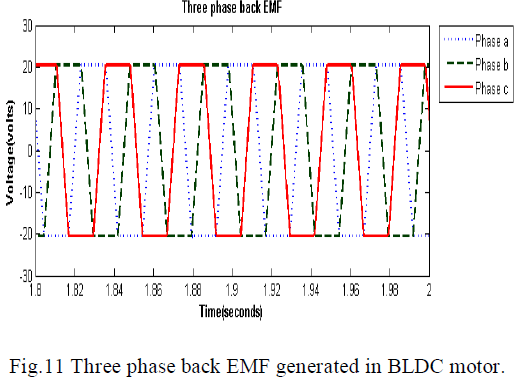 |
| The back EMF produced for the proposed system in the BLDC motor is trapezoidal in nature.This back EMF is very advantagous for the reduction of torque ripple in the system by designing a observer.Also for sensor less system the back EMF serves as the means of postion sensing of the rotor.Figure 12 shows the three phase current drawn by the BLDC motor. |
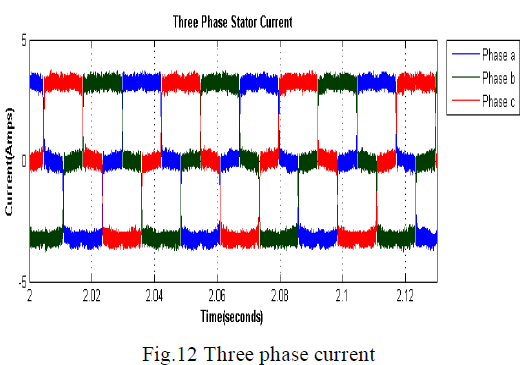 |
| The battery used in the storage system has charing current and voltage.Fig. 13 and Fig. 14 shows the battery charging current and voltage waveforms. |
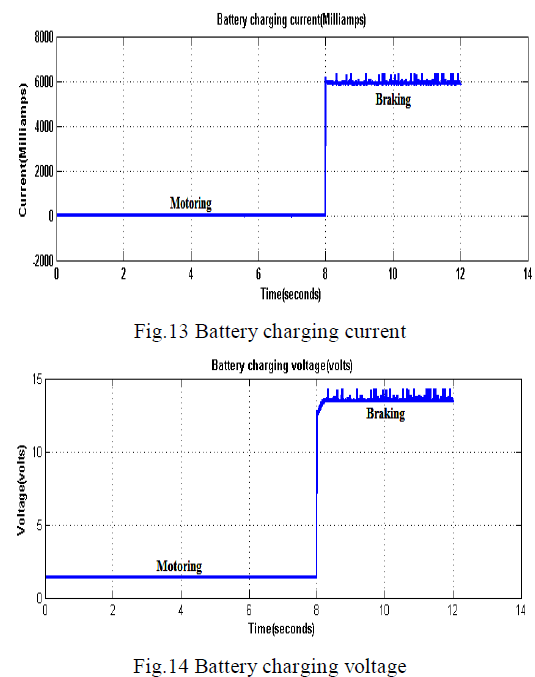 |
| Fig. 15 and Fig. 16 shows the torque in forward and reverse motoring periods. |
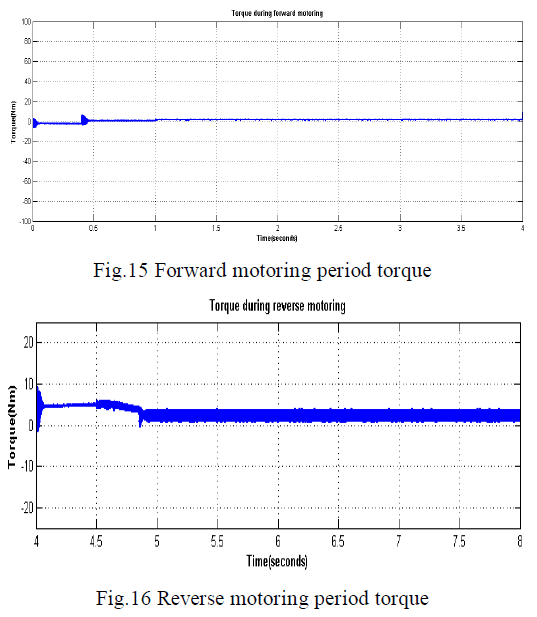 |
| The setling time for forward motor is optimized to 0.45 second from the conventional 0.65 second in case of forward motoring and for reverse motoring it has been improved to 0.85 seconds from 1.1 seconds. |
VI. CONCLUSION |
| This paper presents the analysis of four quadrant operation of a brushless DC motor via MATLAB/SIMULINK, so that one can evaluate the performance of the BLDC motor control with various Control schemes using MATLAB/SIMULINK. The control and PWM-generation logic block then can be transferred to digital hardware circuit in VHDL hardware description language for co simulation verification in the MATLAB/SIMULINK and ModelSim environment which will be explained in the hardware implementation part which is the future work. |
| The significant advantages of the proposed work are: excellent speed control, smooth and faster transition between the quadrants, optimization of torque ripple and energy saving during regenerative mode of operation. |
References |
|